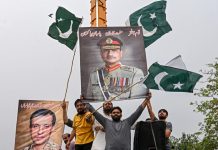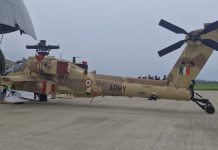The US-led NATO has been fighting the Afghan Taliban for almost two decades, but peace in Afghanistan seems to be lightyears away. As the bloodshed continues, at least 23 civilians were reportedly killed in an airstrike in Garmsir district in Helmand province conducted by pro-government forces against Taliban.
Afghanistan-Pakistan “Undeclared War” Must End; Ashraf Ghani Urges Pakistan
Extremists Continue to Wage War
Sunni violent extremists, most notably the ISIS and Al-Qaida pose terrorist threats worldwide. Experts say their attacks will be most frequent in or near conflict zones or against enemies that are more easily accessible.
According to a survey by the Director of National Intelligence (DNI) Sunni violent extremist groups are geographically diverse; they are likely to exploit conflict zones in the Middle East, Africa and Asia where they can co-mingle terrorism and insurgency. Now, there is growing evidence that world powers are arming global terrorist groups, namely the ISIS and Al-Qaida. Both this groups are regarded deadly by the United States as they threaten US interests.
The DNI report highlights that Al-Qaida will remain a major actor in global terrorism because of the combined staying power of its affiliates and the Taliban. Following 9/11, the United States declared a ‘War on Terrorism’ and stationed its troops in Afghanistan to topple the Taliban. But the focus soon shifted to Iraq; the US invaded Iraq in 2003. With more than 120,000 American troops in Afghanistan in 2010, Washington did not manage to have a lasting effect on the relentless Taliban insurgency.
- Russia Will Host Taliban-Afghan Govt Peace Talks; India, Pakistan Invited
- Chabahar Port Exempted From US Sanctions; Victory For India-Afghanistan Trade Relations
Was the Taliban better equipped than the troops? Did they outnumber them? According to Counter-Currents the Taliban fighters are adept at hit-and-run guerilla tactics and have a much better understanding of the Afghan territory compared to the US soldiers. “They have managed to overrun and hold vast swathes of territory not only in the traditional Pashtun heartland of southern Afghanistan such as Helmand but have also made inroads into the northern provinces of Afghanistan, which are the traditional strongholds of the Northern Alliance comprising Tajiks and Uzbeks.
The outreach of the Taliban in northern Afghanistan bordering the Russian satellite states Tajikistan, Uzbekistan and Turkmenistan has come as a surprise. It has been commonly believed that the Taliban are the proxies of Pakistan’s military which uses them as ‘strategic assets’ to offset the influence of India in Afghanistan.
According to the Pentagon, combat missions officially ended in Afghanistan in 2014; US forces serve only as ‘advisers’. The unprecedented three-day June (2018) cease-fire was followed by secret US – Taliban talks in Qatar in July. This was the first step towards a major reconciliation in years. But this was followed by the assault on Ghazni in August; 19 districts were destroyed. According to Time, the battle was a major test of the Trump administration’s long-term military strategy, which hinges on defending population centres while ceding much of the remote countryside to the Taliban.
The United States has been seeking direct talks with the Taliban for a more direct negotiation between the Afghan government and the Taliban. In the October (2018) meeting, the Taliban focused on the need for a ‘real and Afghan-inclusive solution’. They also talked about the end of occupation and a peaceful resolution for the Afghan issue. Taliban spokesman Zabihullah Mujahid stressed that foreign troops presence in Afghanistan remains the ‘greatest obstacle’ to peace.
While both parties, the US and Taliban have described as productive and positive, siege continues. Despite years of numerous confrontations, battles and dialogue, nothing constructive has been achieved.
By: Syed Shafiq-ul-Haq, Karachi




